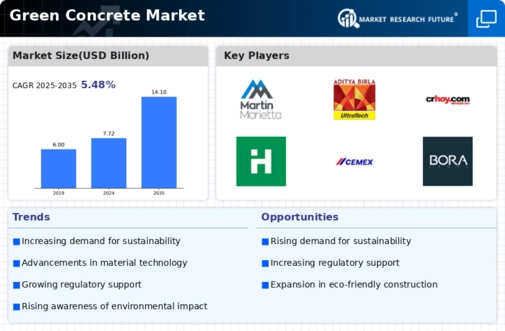Top Industry Leaders in the Green Concrete Market
 The construction industry, long notorious for its environmental impact, is witnessing a seismic shift towards sustainability. At the heart of this change lies the burgeoning green concrete market driven by a confluence of environmental concerns, government regulations, and technological advancements. This analysis delves into the competitive landscape of this nascent market, exploring the strategies, factors influencing market share, industry news, and recent developments shaping its trajectory.
The construction industry, long notorious for its environmental impact, is witnessing a seismic shift towards sustainability. At the heart of this change lies the burgeoning green concrete market driven by a confluence of environmental concerns, government regulations, and technological advancements. This analysis delves into the competitive landscape of this nascent market, exploring the strategies, factors influencing market share, industry news, and recent developments shaping its trajectory.
Strategies for Greener Profits:
-
Product Innovation: Leading players like HeidelbergCement and LafargeHolcim are developing greener alternatives to traditional Portland cement, such as geopolymers and slag-based binders. These offer reduced carbon footprint and improved performance, attracting environmentally conscious clients. -
Circular Economy Principles: Embracing closed-loop systems is gaining traction. Companies like Ecocem and Holcim are incorporating recycled materials like fly ash and construction waste into their green concrete mixes, reducing reliance on virgin resources and minimizing waste. -
Carbon Capture and Storage (CCS): Integrating CCS technologies into cement production facilities is emerging as a game-changer. Companies like CEMEX are investing in pilot projects to capture and store CO2 emissions, reducing their environmental footprint and potentially generating revenue from carbon credits. -
Digitalization and Automation: Implementing smart technologies like Building Information Modeling (BIM) and automated batching systems optimizes resource utilization, reduces waste, and improves green concrete performance, giving companies a competitive edge. -
Strategic Partnerships: Collaborations between green concrete manufacturers, architects, engineers, and construction companies are fostering innovation and accelerating market adoption. For instance, Sika's partnership with LafargeHolcim on a low-carbon concrete project demonstrates the power of collaboration.
Factors Influencing Green Concrete Market Share:
-
Government Regulations: Stringent environmental regulations, like carbon emission caps and green building codes, are driving demand for green concrete. Companies with compliant products and solutions will hold a significant advantage. -
Project Type and Size: Large-scale infrastructure projects and government initiatives often prioritize sustainability, creating lucrative opportunities for green concrete manufacturers. Companies with expertise in these sectors will benefit. -
Cost Competitiveness: While green concrete typically has a higher upfront cost, its long-term benefits like reduced maintenance and potential carbon credits can make it cost-effective. Companies offering competitive pricing and highlighting long-term value will attract customers. -
Brand Reputation and Sustainability Initiatives: Companies with a strong commitment to sustainability and a transparent track record of green practices will attract environmentally conscious clients and investors. -
Regional Market Dynamics: The adoption of green concrete varies globally. Developed economies with stricter regulations and higher environmental awareness are leading the way, while emerging markets offer significant growth potential.
Competitive Landscape
The prominent key players in the green concrete market outlook are the following:
Dow Chemical Company (US)
Eco Green Co. (China)
CICO Technologies Ltd. (India)
CeraTech Inc. (US)
Chryso SAS (France)
Pidilite Industries (India)
Cemex C.B. (Mexico)
Rpm International Inc. (US)
Maipei Ltd (US)
BASF (Germany)
Recent Developments:
November 2023: To decrease greenhouse gases during the process of cement manufacture and blending, Heidelberg Cement has introduced a low-carbon cement brand that features lower carbon dioxide emissions.
May 2023: As a part of its previously disclosed plan to double capacity in five years, Adani Group-owned Ambuja Cements Ltd. said it will expand its production capacity of blended cement by 14 million metric tons. Orders were placed by Ambuja to expand clinker capacity by eight million tons at two units, which would run on green power or renewable energy and help grow the production of blended green cement by 14 million tons.
March 2023: Holcim Mexico has started producing its Fuerte Mas reduced-CO2 cement at its cement plants in Tabasco and Macuspana at a rate of 60,000t/yr combined.
